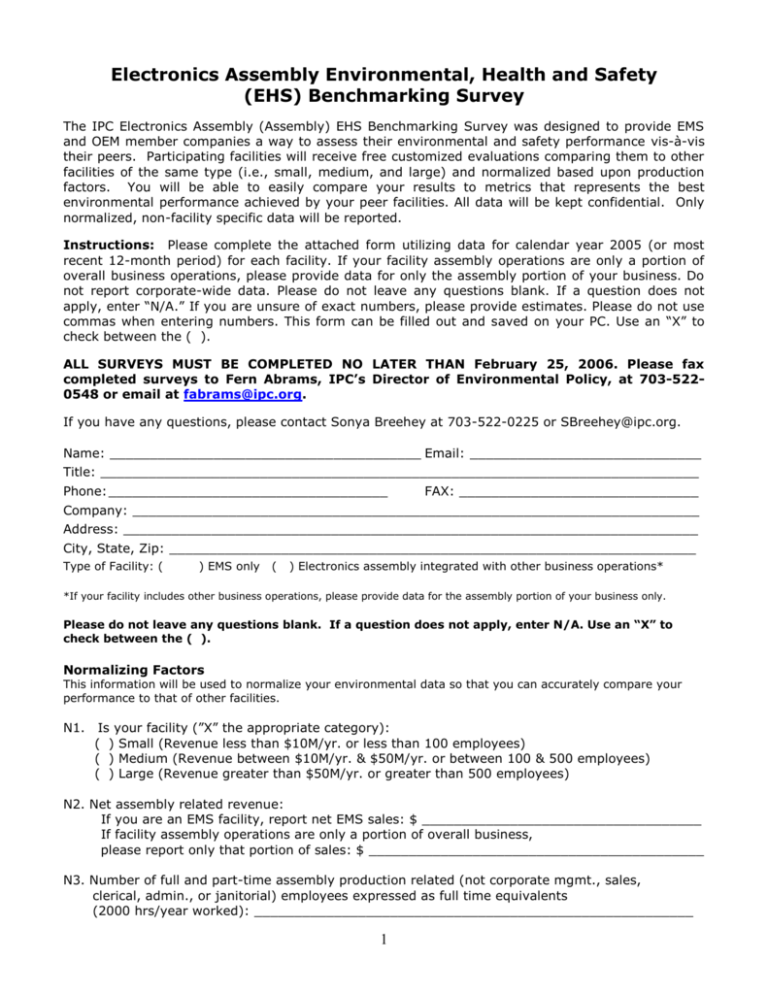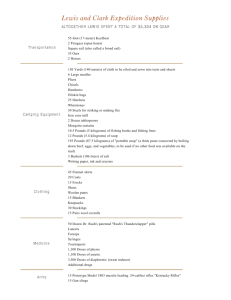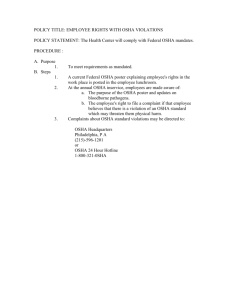Electronics Assembly Environmental, Health and Safety
advertisement

Electronics Assembly Environmental, Health and Safety (EHS) Benchmarking Survey The IPC Electronics Assembly (Assembly) EHS Benchmarking Survey was designed to provide EMS and OEM member companies a way to assess their environmental and safety performance vis-à-vis their peers. Participating facilities will receive free customized evaluations comparing them to other facilities of the same type (i.e., small, medium, and large) and normalized based upon production factors. You will be able to easily compare your results to metrics that represents the best environmental performance achieved by your peer facilities. All data will be kept confidential. Only normalized, non-facility specific data will be reported. Instructions: Please complete the attached form utilizing data for calendar year 2005 (or most recent 12-month period) for each facility. If your facility assembly operations are only a portion of overall business operations, please provide data for only the assembly portion of your business. Do not report corporate-wide data. Please do not leave any questions blank. If a question does not apply, enter “N/A.” If you are unsure of exact numbers, please provide estimates. Please do not use commas when entering numbers. This form can be filled out and saved on your PC. Use an “X” to check between the ( ). ALL SURVEYS MUST BE COMPLETED NO LATER THAN February 25, 2006. Please fax completed surveys to Fern Abrams, IPC’s Director of Environmental Policy, at 703-5220548 or email at fabrams@ipc.org. If you have any questions, please contact Sonya Breehey at 703-522-0225 or SBreehey@ipc.org. Name: _______________________________________ Email: _____________________________ Title: ___________________________________________________________________________ Phone: ___________________________________ FAX: ______________________________ Company: _______________________________________________________________________ Address: ________________________________________________________________________ City, State, Zip: __________________________________________________________________ Type of Facility: ( ) EMS only ( ) Electronics assembly integrated with other business operations* *If your facility includes other business operations, please provide data for the assembly portion of your business only. Please do not leave any questions blank. If a question does not apply, enter N/A. Use an “X” to check between the ( ). Normalizing Factors This information will be used to normalize your environmental data so that you can accurately compare your performance to that of other facilities. N1. Is your facility (”X” the appropriate category): ( ) Small (Revenue less than $10M/yr. or less than 100 employees) ( ) Medium (Revenue between $10M/yr. & $50M/yr. or between 100 & 500 employees) ( ) Large (Revenue greater than $50M/yr. or greater than 500 employees) N2. Net assembly related revenue: If you are an EMS facility, report net EMS sales: $ ___________________________________ If facility assembly operations are only a portion of overall business, please report only that portion of sales: $ __________________________________________ N3. Number of full and part-time assembly production related (not corporate mgmt., sales, clerical, admin., or janitorial) employees expressed as full time equivalents (2000 hrs/year worked): _______________________________________________________ 1 N4. Total quantity of individual boards populated in 2005? _________________________________ What was the average size board you populated? (L x W) ______________________________ N5. Indicate the total quantity of solder used in 2005 (If solder use data is not available to you, please use inventory or purchasing data, please indicate Kilograms or Pounds): Paste _______________________ Kilograms Pounds Bar _______________________ Kilograms Pounds Wire _______________________ Kilograms Pounds Water Use Please enter data from facility water/sewer bills and circle the applicable unit of measurement. U1. Volume of municipal water purchased (annually): _________________ Gallons Kgal Cf Ccf U2. Volume of private well water used (annually): ____________________ Gallons Kgal Cf Ccf U3. Unit cost of municipal water/sewer: $ _________________________ per Gallon Kgal Cf Ccf U4. Fixed water/sewer costs (e.g. annual permit fees, laboratory monitoring costs): $ _______________________________ Water Treatment Municipal and well water is often treated before use to remove hardness and other impurities. Used water may also be treated prior to sewer discharge. T1. Does your facility treat raw water before use? ( ) Yes ( ) No T2. If yes, which raw water treatment methods do you employ to treat water before use? ( ) Reverse Osmosis (RO) ( ) Softening ( ) Deionization (DI) ( ) RO/DI Combined System T3. Do you treat wastewater before discharging it to the sewer? (i.e., Chemical treatment, filtering, etc.) ( ) Yes ( ) No T4. Do you have wastewater discharge limitations such as lead, or other metals/chemicals? ( ) Yes ( ) No Wastewater Recycling Water recycling involves certain technologies that process wastewater so it can be reused. R1. Does your facility recycle water? ( ) Yes ( ) No R2. If Yes, which water treatment methods do you employ for water recycling? ( ) Reverse Osmosis (RO) ( ) Ion Exchange (IX) ( ) RO/IX combined system ( ) Other ______________________________________ R3. Cost of water recycling chemicals (e.g., acid, base, etc.) $ ___________________________ R4. Cost of supplies (e.g., resins, filter cartridges) $ ___________________________ Waste Management Please provide the requested data and circle appropriate unit of measurement. If a question does not apply, enter N/A. W1. Quantity of all hazardous waste shipped off-site for recycling/disposal: ______________________________ Kilograms 2 Pounds Tons W2. Cost for recycling/disposal of all hazardous waste. Include container rentals, transportation fees, disposal fees, and taxes: $ _________________________________ W3. Quantity of packaging waste (e.g. cardboard, plastics, etc.) generated onsite? __________________ Cubic Yards Pounds W4. Quantity of waste packaging recycled? __________________ Cubic Yards Pounds W5. Annual net cost (minus revenue, if applicable) of packaging waste disposal: $ ______________ Pollution Prevention/Management Approaches Answer Yes if you have performed the following within the past 3 years (2002 to 2004). P1. Have you conducted a pollution prevention assessment at your facility to identify waste reduction opportunities? ( ) Yes ( ) No P2. Have you established/used a system where employees can generate, propose, and implement pollution prevention ideas? ( ) Yes ( ) No P3. Have you implemented projects to substitute hazardous chemicals (other than lead) with nonhazardous or less hazardous chemicals? ( ) Yes ( ) No P4. Indicate which of the following management approaches apply to your facility. This information will be used along with other data to determine if certain management approaches impact environmental performance. ___ ___ ___ ___ ___ ___ Employees are organized into work teams and given certain management responsibilities. Company uses Statistical Process Control (SPC) or other statistical methods in its day-to-day quality procedures. Engaged in Total Quality Management (TQM) or similar program. Company is working toward or achieved ISO 9000 certification. Company is working toward or achieved ISO 14001 certification. Company has an environmental management system (EMS). Lead-Free LF1. Do you offer lead-free assemblies? ( ) Yes ( ) No LF2. Do you have a process line dedicated to lead-free assemblies? ( ) Yes ( ) No LF3. List the predominant lead-free solders/solder pastes used in terms of the alloy components: (Sn, Ag, Bi): _____________________________________________________ Lead TRI Reporting The following questions relate to EPA’s Toxic Release Inventory (TRI) reporting requirements for lead. TRI1. Did you report lead for RY 2004 TRI Reporting? ( ) Yes ( ) No TRI2. Did you report lead air emissions on your 2004 TRI Form R? ( ) Yes ( ) No TRI3. Did you report lead in wastewater discharged on your 2004 TRI Forms? ( ) Yes ( ) No TRI4. Did you report offsite disposal of lead, other than solder dross, on your 2004 TRI Forms? ( ) Yes ( ) No TRI5. How long did it take you to complete the lead TRI reporting forms? 3 ____________ Hours Air A1. Do you apply conformal coatings? A2. If yes, which conformal coatings do you apply? (Check all those applied) A3. ( ) Yes ( ) No ( ) ER ( ) UR ( ) AR ( ) SR ( ) XY Are volatile organic compound (VOC) air emissions a permitting concern for your facility? ( ) Yes ( ) No A4. Do you have air emissions control equipment for your VOC emissions? ( ) Yes ( ) No A5. Indicate the type(s) of cleaning solvent/system(s) used in your facility? ( ) Aqueous ( ) Semi-aqueous ( ) Solvent (indicate type used) ___________________ Energy Use Please enter data from facility energy bills. Energy Source 2005 Usage Electricity Natural Gas Fuel Oil *Note: 1 therm = 1 ccf. 2005 Average Unit Cost kWh Therms* Gallons $/kWh $/therm $/gallon Safety & Health Please provide the requested data from your OSHA 300 Report for 2005: S1. Number of Injuries/Illnesses Resulting in Days Away From Work (Total from column H on the OSHA 300 Report for 2005) ________________ S2. Number of Injuries/Illnesses Resulting in “Job Transfer or Restriction” (Total from column I on the OSHA 300 Report for 2005) ________________ S3. Number of “Other Recordable Cases” of Injuries/Illnesses Without Lost Workdays (Total from column J on the OSHA 300 Report for 2005) ________________ S4. Total Number of OSHA Recordable Injuries/Illnesses (Sum of totals from columns H+I+J from OSHA 300 Report for 2005) ________________ S5. Number of “All other Illnesses” (Total from column M5 from OSHA 300 Report) ________________ S6. Hours Worked - if known ________________ S7. Please rate on a scale of 1 to 5 the following employee safety topics according to your facility’s level of concern for each issue (1 = little concern; 5 = very concerned): ____ Ergonomic Issues (e.g., sprains, strains, CTDs, CTS, RSIs) ____ Indoor Air Quality (e.g., chemicals, mold) ____ Equipment Safety (equipment qualifies to certain safety standards prior to purchase) ____ Chemical Exposure/Hygiene (e.g., lead or solvent exposure to employees) ____ Other (Please describe) ________________________________________________ Please FAX (703-522-0548) or email (fabrams@ipc.org) completed surveys to IPC by February 25, 2006! 4







